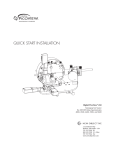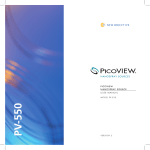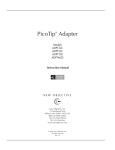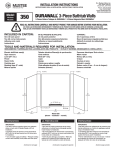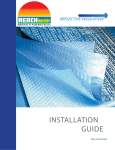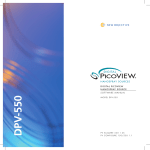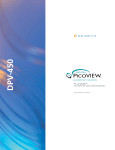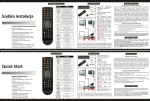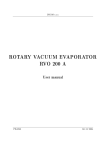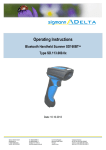Download User's Guide - New Objective, Inc.
Transcript
Model PIP-500 Pressure Injection Platform User’s Guide New Objective, Inc. 2 Constitution Way Woburn, MA 01801-1023 USA 888 220 2998 Orders 781 933 9560 Phone 781 933 9564 Fax www.newobjective.com © 2004 New Objective, Inc. All rights reserved. Rev 1.0 NEW OBJECTIVE The New Objective PIP-500 pressure system for “bomb” injection sample loading is specifically designed for use with the magnetic interlock plate design of the new PicoView™ 150, 400 and 500 Series. With no tools — or even screws — required the PIP500 is simple to use. The system includes a universal magnetic holder for use with sources other than PicoView. Tools and supplies needed for installation: Crescent wrench Length of stainless steel, copper or Teflon tubing Supply of high-purity helium Set of Allen wrenches (supplied) Contents of PIP-500 package (1) (1) (1) (1) (1) PIP-500 Pressure Injection System Plexi-glass protective shield Set of Allen wrenches Accessories Box - (3) Insert Sleevs - (5) Grauated micropipettes - (1) magnetic union holder - (10) SealTight™ Sleevs - (5) SealTight Ferrules - (1) Snubber Fitting - (2) Short PEEKNuts - (3) Low-head Screws (for plexi-glass shield) - (1) Valve component PIP-500 User’s Guide 1 PIP-500 Pressure Injection Platform The PIP-500 is shipped with the protective shield separate. It is recommended that the protective shield be attached before operating the pressure injection system. WARNING: Always wear ANSI-approved protective goggles while operating any high-pressure instrumentation. Installation of Gas Supply Figure 1 Before helium gas is supplied to the pressure injection platform the protective shield should be installed to the base of the unit using the three low-head screws supplied in the accessories box. For your convenience a set of Allen wrenches is supplied with the unit. The protective shield has been designed to protect the user during the injection process and once installed should not be removed. (Figure 1) 1. Find the three low-head screws in the accessories box. 2. Locate the three tapped holes in the base of the PIP-500. Place the bottom of the plexi-glass shield against the base of the PIP-500 unit. Align the holes in the shield to those in the base and secure with the three low-head screws. WARNING: Do not attempt to operate unit without the protective shield securely locked in place. 2 NEW OBJECTIVE The helium is supplied to the pressure injector though a swagelock three way valve attached to the pressure vessel. A swagelok fitting designed to accommodate 1/8” tubing is supplied in the accessories box, as seen in Figure 2. The valve is shipped without the proper fittings attached. Attach the fitting to one side of the valve. For convenience choose the side which is closest to the location of the helium source. Using Teflon tape is recommended to ensure a tighter seal. 3. On the other side of the valve attach the Snubber fitting. The snubber fitting contains a porous stainless steel frit which acts to protect liquid samples from pressure shocks and surges as helium is released from the pressure vessel. (Figure 2) 4. Lastly attach the supply of helium to the 1/16” fitting. Teflon tape may again be applied for a tighter seal. Follow the instructions provided to properly tighten the swagelok fittings. Figure 2 Operation of the 3-Way Valve 1. Pressurize the vessel by turning thethe ointed side of the valve knob towards the helium source. 2. Placing the valve in the neutral position will stop the flow of gas either in or out of the vessel. 3. Turn the poited side of the valve knob towards the snubber firring to release pressure from the vessel. 3 PIP-500 Pressure Injection Platform Sample Loading 1. Remove the cap from the pressure vessel by unscrewing it counter clockwise. Place the cap on the grooved insert on the center platform. The pressure vessel is sealed with an o-ring (Figure 3). Make sure to periodically inspect the o-ring for possible wear and cleanliness. Figure 3 2. Three inserts (Figure 4a) are available to hold a wide variety of sample vials (Figure 4b). They are located in the accessories box. Choose the most appropriate insert for your sample vial and place both in the pressure vessel as shown in Figure 5. The pressure vessel features a spring-loaded well to allow the insert to be easily inserted and removed. Figure 4a Figure 4b Figure 5 4 NEW OBJECTIVE Liquid junction Column Fused silica Figure 6 3. The Pressure Injection Platform has been designed with PicoView customers in mind. With the PicoViews magnetic stages, sample loading is quick and easy. Figure 6 displays a magnetic stage from a PV-500. Secured to the stage is an uncoated tip module (UTM) housing a liquid junction contact tee and a tip holder use to secure the tip of a PicoFrit column. A sample can be injected directly onto the PicoFrit column or through a piece of fused silica on the other side of the tee. 4. To perform the injection, place the magnetic stage on the center platform as shown in Figure 7. The platform system holds the stage securely during column sample loading. Thread the back end of the column or fused-silica tubing through the SealTight fitting on top of the pressure vessel cap. (SealTight sleeves, ferrules and nuts are supplied in the accessories box) A series of markers have been set into the platform support to be used to judge the proper depth of the capillary column/fused silica (Figure 8). Figure 7 5 PIP-500 Pressure Injection Platform Figure 8 5. With the sample vial inserted into the vessel, place the entrance end of the column and the cap on the pressure vessel and tighten. (Figure 9) Be careful not to crush the back end of the column within the sample vial. It may be best to tighten the SealTight fittings after the cap is firmly in place so this does not occur. Figure 9 6. A magnetic column holder has been supplied to enable the loading of columns without the magnetic stage plate. The holder is designed to secure the tip of a PicoFrit column using a PEEK™ union. (Figure 10) The holder may also accept any nanobore column. Figure 10 6 NEW OBJECTIVE 7. Before the gas is applied to the pressure vessel make sure both the SealTight fitting on top of the cap and the cap itself is secure and fully tightened. Make sure the three way valve is in the neutral position (straight up and down). Apply approximately 400 psi of pressure of high-purity helium and turn the three way valve to allow the helium pressure into the vessel. WARNING: Maximum pressure: 1,000 PSI Figure 11 8. The amount of sample injected can be monitored by measuring the displaced liquid from the tip of the column with a graduated capillary. The pressure injection platform has been designed with a capillary holder providing hands-free measurement of injected sample volume. (Figure 11). 9. Place a graduated capillary within the clamp and gently secure it by turning the top screw on the holder. The capillary can be rotated towards the tip of the PicoFrit column and secured by tightening the bottom screw on the holder. Be careful not to touch the end of the PicoFrit column. To avoid breaking the tip always aim the capillary on the side of the emitter (Figures 12a and 12b). Figure 12a 9. After injection turn the supply of helium off and turn the two way valve towards the Snubber fitting. This will slowly bleed off the pressure within the vessel leaving the liquid sample undisturbed. 10. Remove the column from the pressure vessel and reattached it to the LC system be begin elution. Figure 12b 7 PIP-500 Pressure Injection Platform Trademarks The following trademarks are found in this instruction manual: MicroTight and SealTight are trademarks or registered trademarks of Upchurch Scientific, Inc.; PEEK and PEEKsil are trademarks of Victrex plc; PicoView, PicoTip, PicoFrit, SilicaTip, TaperTip, and PicoTip Powered are registered trademarks or trademarks of New Objective, Inc. Limited Warranty DISCLAIMER Technical information contained in this publication is for reference purposes only and is subject to change without notice. The information is believed to be reliable and accurate; however, nothing set forth herein constitutes a warranty of any kind or nature. Given the variety of experimental conditions, New Objective, Inc., cannot guarantee performance at a given flow rate; the best guide to tip selection and operation is empirical testing. NOTICE: The user is solely responsible for complying with any patent(s) pertaining to applications or methods using the products described or mentioned in this manual. New Objective, Inc., warrants this Product (Pressure Injection System) to be free of defects in materials and workmanship for a period of one (1) year from the date of shipment. New Objective, Inc., warrants the accompanying fittings and accessories to be free of defects in materials and workmanship for a period of ninety (90) days from the date of shipment. Any item believed to be defective within the meaning of the foregoing sentence shall be returned to New Objective, Inc., and, if found by us to be defective, shall be repaired or replaced with conforming Product of like kind. Please note that a Return Authorization Number will be required. New Objective, Inc., will pay return freight on unsatisfactory items. New Objective, Inc., shall have no other liability or obligation with respect to goods alleged to be defective. The foregoing shall constitute the sole and exclusive remedy, and New Objective, Inc.’s total liability for any and all losses and damages arising out of any cause whatsoever (whether such cause be based in contract, negligence, strict liability, other tort, or otherwise) shall in no event exceed the purchase price of the Product(s) in respect of which the cause rose. New Objective, Inc., disclaims, and shall not be liable, in any event, for loss of profits, consequential or incidental damages, or punitive or exemplary damages in connection with the Product furnished hereunder. The foregoing limited warranty (i) shall be void as to any item of Product which is in any material respect altered by the user, and (ii) does not cover misuse of the Product (for example, but not limited to, dropping or other mishandling of any components of PicoView®, improper trimming of SilicaTips™, PicoFrit® columns, or TaperTips™, damage caused by application of or exposure to excessive temperature, pressure, or voltage) or SilicaTip, PicoFrit, or TaperTip failure by reason of clogging. 8 NEW OBJECTIVE 9












